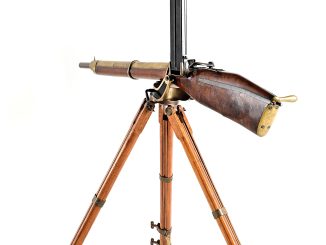One of the perennial challenges facing authors of firearms reference books is balancing the very technical nit-pickery with the broad historical view of a gun and its context in world events. The emphasis is usually tending towards the technical, but Neil Alpinshaw has done an excellent job of balancing the two, and made the development of the Martini-Henry an engaging story at the same time (a rare feat in this genre!). His new book “The Martini-Henry: For Queen and Empire” mixes vivid descriptions of British troops fighting across the far-flung corners of the world with their trusted Martinis with a history of the development and modernization of the rifles (and carbines).
Most interesting to me personally was the section on the Martini-enfield, which was to be the improved version of the Martini-Henry. Chambered for a smaller-bore .402 caliber cartridge and fitted with sights for rapid close-in combat as well as long-range volley fire and sporting a quick-loading magazine attached to the receiver, this is a fascinating look at the highest evolution of the single-shot black-powder military rifle. Its development was dashed by the bolt action Lee and the development of smokeless powder, and the many thousands initially produced were converted into other patterns before seeing service.
Aspinshaw also tackles many of the long-standing myths about the Martini, and particularly its weaknesses. He takes his information directly from period investigations and after-action reports, and avoids the common hearsay. He does not let his own personal passion for the subject prevent him from articulating the true problems the rifles had, but clears away the misconceptions that have become prevalent (like the impossible-to-open ammunition boxes).
Published by International Military Antiques, the cover price is $60, and it is worth every penny for anyone interested in the grand Victorian British Empire or the Martini as a firearms family. Available direct from IMA or through Amazon:




“(…).402 caliber cartridge(…)”
municion has query about it: http://municion.org/Enfield/402EnfieldMartini.htm
I am not sure, if I understand it right: was it developed originally for machine gun (meaning: hand-cranked rapid-fire gun like Gardner)?
“(…)quick-loading magazine attached to the receiver(…)”
Interestingly according to http://www.martinihenry.org/index.php?route=product/product&product_id=78
A simple pressed metal magazine which held eight rounds, clipped onto a special morticed bracket screwed onto the right side of the action, and could be stowed away, ready loaded in the valise when not needed but rapidly fixed into place when the need required.
That “magazine” sounds a lot like the modern side saddle shell holders used on tactical shotguns. There’s also at least one antitank rifle with a similar receiver mounted ammunition box.
Would like to see a video or series of videos showing how the Peabody became the Martini.
Peabody actually manufactured martinis for the Ottoman empire
They seem to have accepted von martini’s adaptations and modifications (self cooking, override trigger, coil mainspring…)
The peabody Martinis that the Ottomans went on to convert to 7.65x54mm rimless, required applique bolstering to resist stretching.
The British made martinis, did not require bolstering to handle the equivalent ballistics of the .303 mk7 and mk8.
Thanks for the review Ian, I own a mk. 4 long lever and will be picking up this book shortly.
Thank you Ian
I think I’ll be getting that book.
It sounds like the sort of treatment that I’m into
The whats and the whys the whens, a day the hows are all interesting
But so are the whos and their backgrounds and personalities and their political connections.
We’re not absolutley not dealing with a Marxist materialist dialectic where technology advances itself and then determines the “social relations” (old Karl (bees pee upon him) never believed it himself).
We’re far more in the territory of Thomas Kuhn (The structure of scientific revolutions) and Murray Rothbard’s “contra-whig theory of history”
The Mileu of Victorian and Edwardian Britain lives on in the game shoots. We can see how people rise to influence and how their experiences colour their opinions and choices. We can also see how loud mouthed gobshites pop up.
__________________
I absolutely love Martinis*
It took a while to work out the geometry and kinematics of the action, but onceyou understand it, it’s good
Warren Page (The accurate rifle) said that a BSA martini was the only non bolt action he knew of that regularly took home the silver at bench rest competitions
Robert Snapp up in Michigan (I hope he’s still alive and well! he’s got to be getting on for 90 or more now – I found out about him through Ross Seyfreid (since Elmer Keith died, Seyfried is probably the only contributor to the gunzines for the hard of thinking, who actually knows what he’s writing about)) had a very high opinion of Martini actions and produced rimless extractors for the BSA martinis, along with superb high end custom rifles on martini actions.
The British Martini service rifle, did have its faults (mostly attributable to the coiled brass foil cartridge cases – accounts of British officers in the Ottoman Caliph’s [dysfunctional] armies, suggest that even with the poorer quality American Peabody made actions, the extraction problems that the British empire experienced, were not experienced with the Caliphate’s solid drawn brass cases.
____________________
* that’s what I tell them to get them to go to bed with me, and they’re good fun when they get there 😉
I hear that these old rifles were used firing volley-fire. Can someone explain to me difference between volley and salvo? Thanks.
Hmmmmm
Does that distinction include a difference?
Or not?
Definitions are not the same everywhere, to put it mildly. But usually a salvo means that all soldiers fire on command at the same instant. Volley-fire usually describes a body of soldiers, firing in a coordinated way at long range at the same target, but each soldier individually decides when he pulls the trigger. Salvos are very difficult to achieve in combat. The machine gun replaced both.
Maybe it’s just me. Everytime I decide I want to buy an old rifle, Ian does a video. And then the masses buy those guns he speaks about. Keep it up Ian. I will find the one I want. Someday, maybe.
The $60 seems fairly reasonable, but both amazon and IMA charge a whopping $50+ for shipping to the UK! That’s shot off the interest I had in buying it.
I look forward to reading it, though the price now approaches what was the norm for the old hardbound Collector Grade Publications about ten years ago.
Lol.
My late father insisted on wearing a Sudan campaign issue Wolseley Pith Helmet .. whenever the sun shone. He insisted on it as being the best headgear in the tropics… to dad, born in the Cairngorm Mountains in the Scottish Highlands and living in Edinburgh,Scotland, the ‘tropics’ meant France in July on the annual family holiday.
I still have not recovered from the teenage trauma of him wearing this in Paris, in the boutiques of the Bvd de Bolougne, in 1984, in a khaki shirt, shorts, knee length khaki socks…. with flashes…and ammunition boots, his appalled family walking 10 yards behind him whilst he held forth about the poor fighting qualities of the early 19th C Frech sailor….
I still have the helmet, unfortunately it doesnt fit me, my head is too large.
This book is indeed very interesting, and I read it a not long time ago because I participated in one university project connected to the history of weapons. And I wrote not a review, but it was a research paper. I found a lot of books and other writing connected to the history of weapons, but I still faced some writing troubles. So when I had only one half ready, I decided to use https://paperell.net/buy-research-papers to get professional help and buy research papers. And it’s good that I had a draft because very soon, I recieved the finished writing, which turned out to be very interesting. And if someone is interested, I can say which books I used, and maybe for someone, it will be interesting to read them too!